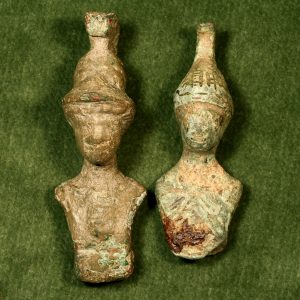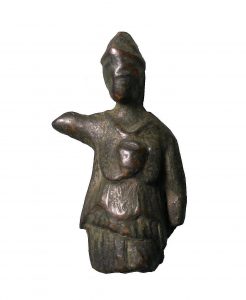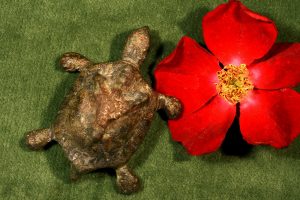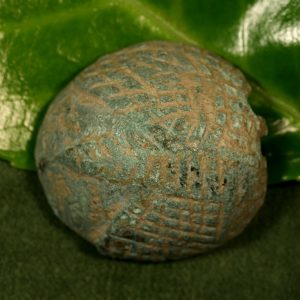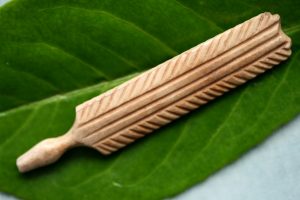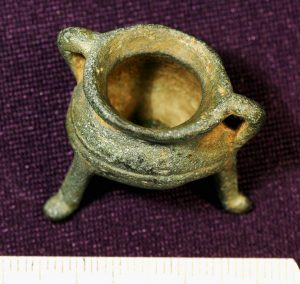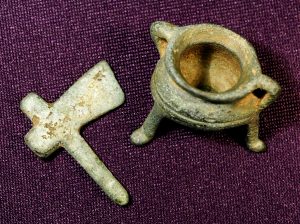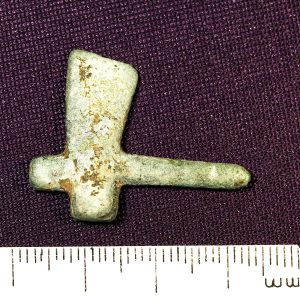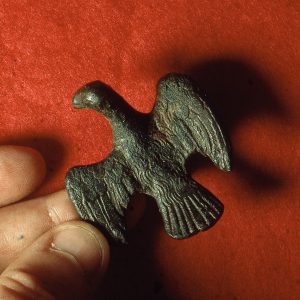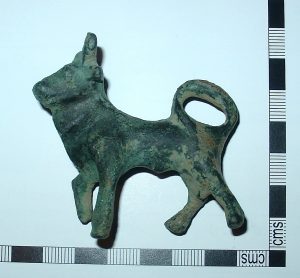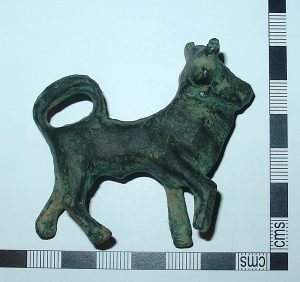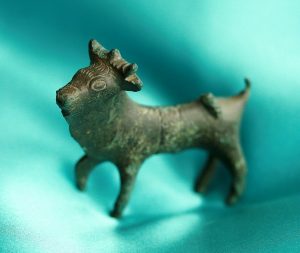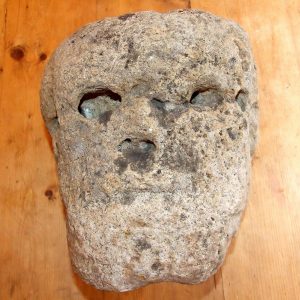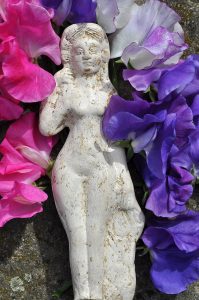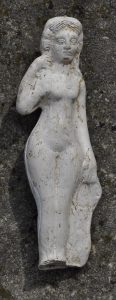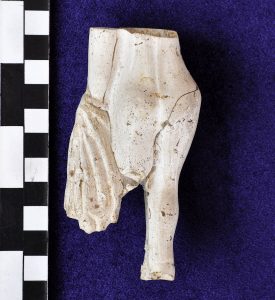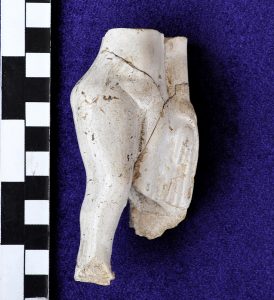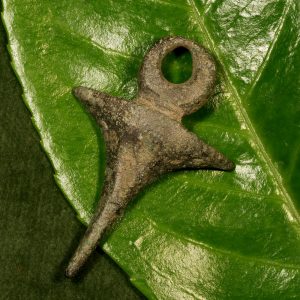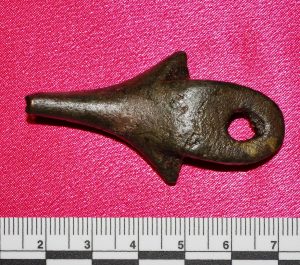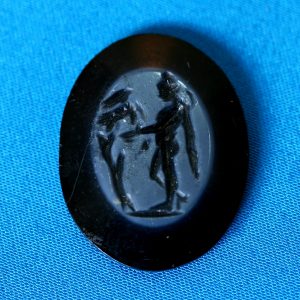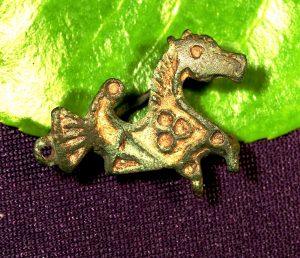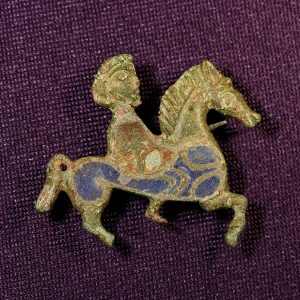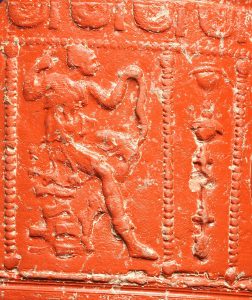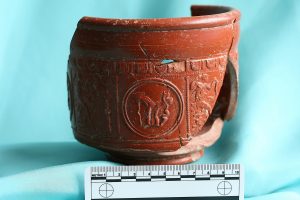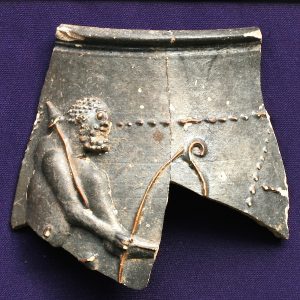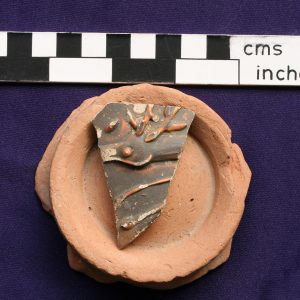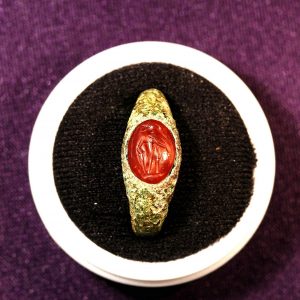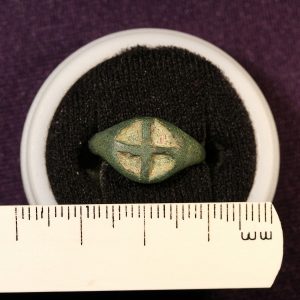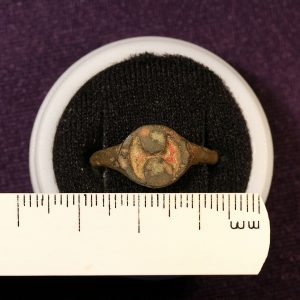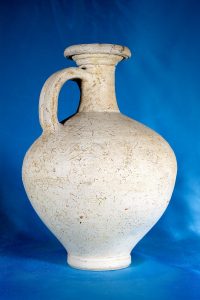< Wealthy Little Girl Cremation
Votive Artefacts
- Two bronze Minerva knife handles / votive statuettes. Protective talisman bringing Minerva’s wit and talent to the dinner table
- Bronze Minerva figure
- Bronze tortoise symbolising music. Mercury’s creature
- Bronze tortoise shell shaped lid. Possible seal box lid
- Votive headdress feather carved bone. Religious purpose
- Two miniature copper alloy cauldrons one two legged the other three. The more sophisticated three-legged cauldron is from Alconbury Weston. The other is from central Godmanchester
- Two bronze miniature axes. Well-made axe. More rudimentary axe
- Bronze house temple eagle, symbolising Jupiter, god of Rome
- Bronze bull travelling votive figurine
- Bronze bull with four-horned corona
- Godmanchester Iron Age Horned Head. A cult head with magical properties
- Godmanchester Venus figurine, possibly from Mansio temple. Nine glass beads cremation burial
- Ralph Clark’s fragment of Venus. Probably a temple figurine
- Stylised bull’s head hanging flower pot handle decoration. Household item offering protection from the gods
- Stylised bull’s head hanging flower pot handle decoration 2
- Onyx intaglio ring depicting the king of the gods, Jupiter, god of Rome, in the shape of an eagle and the boy Ganymede. Perhaps considered to confer sexual vigour and wit upon the wearer
- Repoussé Hippocampus Brooch with pin and chain loop on tail. Rare zoomorphic design. Votive value Jupiter’s brother Neptune, lord of all waters and his horse. Safe travel over water
- Horse and rider plate brooch with pin. Well known zoomorphic design. Votive with possible cult significance
- Samian ware cup with Diana, Silenus medallions
- Hercules and stag Hunt Cup
- Stag’s head Nene Valley ware hunt cup
- Bronze carnelian intaglio Apollo ring
- Bronze ring with clockwise moulded swastika
- Silver Cretan archer’s labrys ring
- White ware flagon – grave goods
1. Two Bronze Minerva Knife Handles / Votive Statuettes. Protective talisman bringing Minerva’s wit and talent to the dinner table.
These bronze artefacts probably had a dual role, both practical and spiritual.
Description and comment: Decorative knife handles such as these two bronzes were expensive accessories and popular with the army. These statuette/ knife handles seem to represent Minerva, the Roman goddess of war. Both the large and smaller statuette wear a Corinthian helmet, associated with the goddess. The larger figure has a circlet of braids on top of her head, upon which the helmet is set.
Like so many Roman gods, Minerva had a wide range of responsibilities – war, wisdom, science, and the arts, spinning, weaving and music. She was the daughter of Jupiter, king of the Roman gods, whose counterpart in Greek mythology is Zeus, king of all the Greek gods. Her own counterpart in Greek mythology is Athena or Pallas Athena, daughter of Zeus.
On the larger knife handle you can just see on her breastplate, the aegis, which, in depictions of the goddess shows the form of the Gorgon Medusa. This is considered a protective talisman. The aegis recalls how Perseus triumphed over Medusa. Perseus slew Medusa without having to look at the monster, whose one glance turned all to stone. Minerva lent Perseus her bright shield which he used as a mirror allowing Medusa’s reflection to guide his hand and so enable him to cut off her head. The smaller figure is so worn it is not possible to see the aegis.
Professor Stephen Upex suggests that the statuettes could have had a dual role. Holes at the base would have allowed them to take an iron blade, but with a wooden support inserted could also have supported votive figurines for a lararium altar (a household temple altar).
These figurines could also be spatula handles or wax spatula handles – a similar Minerva was found at Reepham.Professor Upex prefers the knife handle explanation.
Minerva is often identified with the Celtic goddess, Sulis who is a sky goddess and healing deity. In Bath, well known for its healing waters today and in ancient time, Sulis Minerva is the name for the local healing deity, accepted by Iron Age people and also Romans.
Archaeologist Michael Green who was one of the first archaeologist to fully comprehend the importance of Roman Godmanchester, agrees that the figures are not only knife handles but also votive figurines. In this case, he feels they represent local Celtic deities, deities which are perhaps identified by the native people, with Minerva. He suggests that the figurines’ military accessories and aegis have been adopted from Minerva, but they themselves are representations of the local Romano-British tutelary deity of the town of Durovigitum.
He writes ‘They are metal parts of statuettes which would have been slotted into a painted wooden body. They are either votive figurines to be presented at a local temple, or perhaps more likely Lares, or protective household deities. They would have been sold at a local temple at Godmanchester.’
Michael Green continues, ‘The Roman town lies in the border territory of the Late Iron Age tribe, the Catuvellauni, who like the tribal Iceni of Norfolk had a war goddess to whom human sacrifice was made. In the wake of the Boudiccan rebellion in 60 AD, such deities took on a new Romanised status and became regional female deities with responsibilities for protecting the land, people, crops and animals. They continued to be supplicated with infant sacrifice, which was only put to an end in 7th century AD Godmanchester by the Christian church.
‘These female deities continued to wear the military panoply of Minerva, but carried a reversed spear indicating a peaceful role. The goddess Senuna’s votary hoard at Hinxworth Hertfordshire included a Minerva figurine carrying a cornucopia symbolising plenty. Near the Roman town of Durobrivae not far from Peterborough, another Minerva figurine was found, this time with the attributes of a water pot symbolising a sacred well, which has been identified in a nearby temple complex.
‘We do not know the name of the tutelary Minerva goddess at Godmanchester, but she was certainly worshipped there, possibly at the Romano-British shrine which I excavated in Ralph Clark’s garden in Piper’s Lane. Another bronze figurine of Minerva was found at Green End, Post Street in 1905 and is published in my article ‘Religious Cults at Roman Godmanchester.’
Professor Upex comments that there is no real evidence of infant or human sacrifice other than Tacitus whose remarks may be targeted at a poor audience vulnerable to the propaganda horror of a barbarian enemy.
Michael Green, Pagan Gods and Shrines of the Roman Empire. 1986 ed. Henig and King OUP.’
Dimensions and details
Found: Central Godmanchester.
Date: Late 1st or 2nd century AD.
Length: Large figurine 50mm. Smaller figurine 40mm.
References:
Michael Green, ’Religious Cults at Roman Godmanchester’, Pagan Gods and Shrines of the Roman Empire, 1986. Ed Henig and King. Oxford University Press.
Professor Miranda J. Green ‘The Gods of Roman Britain’ Shire Archaeology. Pp43,44.
Nigel Mills ‘Celtic & Roman Artefacts’. Greenlight Publishing.Ch V.
2. Bronze Minerva figure.
Description and comment: Part of a bronze statuette of Minerva, arms and most of the leg missing, rather worn but with her helmet and with the aegis image of the Gorgon Medusa on her breastplate. Minerva was a very popular goddess particularly amongst soldiers and many were garrisoned in Godmanchester in St Ann’s Lane.
Dimensions and details
Found: Green End house, 1905 by Reverend F.G. Walker. This was his home for a short while. Rev Walker, many of whose finds and some papers are to be found in the Norris Museum, St Ives, describes at least eight wealthy cremation burials in his orchard on Post Street, Godmanchester, some 1st, others 2nd and 3rd century.
Date: Possibly 1st century.
Height: 47mm.
References:
Catalogue. Pottery and clay. Item 10 Pink ware ring necked flask.Norris Museum Roman X 0748. Published CHAS 5, page 454 & PL2.Huntingdon Library and Scientific Institute (British Museum).
Archaeologist Bob Burn- Murdoch, onetime Curator at the Norris Museum who wrote this catalogue entry writes ‘ CHAS refers to the Cambs and Hunts Archaeological Society, a breakaway group from the CAS which ran c. 1900-1950. It was founded because some of its members felt that the CAS didn’t pay enough attention to Huntingdonshire, others were just loopy. The catalogue ref is to the Transactions of the CHAS, which were published irregularly during its existence and ran to seven volumes. CHAS 5 is volume 5. There are copies of the Transactions in the local studies collections at Huntingdon Library, also in the Norris Library.’ Also, Cambridge Antiquarian Society’s Communications Vol X11P 282 (1909). At the NorrisMuseum.
3. Bronze tortoise symbolising music. Mercury’s creature.
Description and comment: Cast copper alloy tortoise of great rarity found in Godmanchester. The tortoise was one of the god Mercury’s creatures. The legend is that Mercury took a tortoise and turned its shell into a lyre, symbolising music as one of Mercury’s powers. Another tortoise can be seen in a group of cast copper alloy figurines accompanying the god at the museum in Verulamian, St Albans. This group includes a cockerel and a goat, also associated with Mercury.
On the back of the Godmanchester tortoise shell a cockerel claw is well defined. The cockerel was regarded as the herald of a new day and symbolised Mercury’s role as messenger to the gods. The ram, seen in the Verulamian group recalls Mercury’s role as protector of flocks and herds.
In 1991 a bronze cockerel, without its feet, was found during the English Heritage Roman excavation at Rectory Farm in Godmanchester. For more than twenty years since the excavation the cockerel seemed to have been lost and only a photograph remained, but now the cockerel has emerged in the English Heritage boxes of items from Rectory Farm.
The tortoise is 47mm in length and the cockerel 45 mm high, both of very similar dimensions but the two figurines were not apparently made to fit one on top of the other. The cockerel’s claw on the tortoise shell is too big for the cockerel figurine. It does not appear to have been broken off from another figurine perched on top and is probably merely a symbolic reference to the cockerel, and a figurine complete in itself.
The find spot of the cockerel in the archaeological excavation area at Rectory Farm, Cow Lane, indicates the likelihood of a household temple to Mercury at the villa which is known to have been a wealthy estate. It is worth noting than a bronze eagle, again probably from a house temple, and in this catalogue, No. 8, is also thought to come from Rectory Farm.
The find spot is disputed, but the best report is that the tortoise was found in Berry Lane, Godmanchester about a mile from Rectory Farm. This might indicate another Mercury based site or simply that the figurine had been carried about as some sort of votive protection for the owner, and lost.
Archaeologist Michael Green says ‘One of the most interesting features of this bronze tortoise is the outline of the cock’s claw on the top of the shell. The cockerel was associated with the Roman god Mercury, as indeed was the tortoise. It is evident that this was originally part of a bronze votive statue of the deity. As the god of Commerce, this would have been highly appropriate in Roman Godmanchester.’
Such a fine tortoise is exceedingly rare. One or two others, very much cruder and without a cockerel’s claw on the back of the shell, have been found in the UK. One is identified in the UK Finds Database, record no 47381 and was found in Kent.
Copyright: Verulamium Museum
Rectory Farm,Godmanchester Copyright: English Heritage
Dimensions and details
Found: Bronze tortoise in central Godmanchester, Berry Lane. Cockerel found during the Rectory Farm villa farm excavation 1991.
Date: Tortoise late 2nd or early 3rd century AD. Cockerel late 2nd or early 3rd century AD.
Length: Tortoise 47mm.
Height: Cockerel 45 mm.
4. Bronze tortoise shell shaped lid. Possible seal box lid.
Description and comment: Attractive bronze tortoise shell shaped lid with the apparent remains of a hinge fitting. This again alludes to the god Mercury. The incised cross hatching decoration depicts the patterned shell of the creature. Small copper alloy tortoise shaped mounts like this one are occasionally found on the lids of Roman seal boxes. These have been reported in Crummy 1983 Colchester Archaeological Report 2. The Roman small finds from excavations in Colchester 1971, Colchester Archaeological Trust 143 no.4237 and date from 2nd century AD, or later. Similar copper alloy tortoise shaped lids are also recorded on the Portable Antiquities Scheme but generally these are very rare and have hemispherical knops which loosely represent the limbs and head of the creature.
This lid has no knops, a difference of style which, with its hinge may mean it is a locally made piece and perhaps fashioned as the lid for a little perfume box. Again, we see here the use of the tortoise referring to its religious musical symbolism as the creature of the god Mercury, god of trade and commercialism but also protector for herdsmen and a messenger to the gods.
Dimensions and details
Found: Area of Godmanchester.
Date: Mid to late 2nd century or early 3rd C AD. As with many metal objects, dates can be disputed. There is some suggestion that this may be medieval.
Length: 35 mm
Ref Crummy 1983 Colchester Archaeological Report 2. The Roman small finds from excavations in Colchester 1971, Colchester Archaeological Trust 143 no 4237.
5. Votive headdress feather carved bone. Religious purpose.
Description and comment: This delicately carved bone votary feather has a worked and finished top. Similar feathers can be seen during the Romano Celtic period imprinted into silver or gold foil. Bone feathers such as this are considered religious or votive objects. The feather is an Iron Age or Romano Celtic motif, perhaps adopted by Roman colonisers. Many are found in temple sites and in some numbers along the Fen edge which is roughly Godmanchester’s location in ancient Roman times.
The bottom part of the votary feather has been worked so that it could be fitted into a base, perhaps belonging to a religious headdress of similar feather, used by priests in a temple in central Godmanchester at this period.
Dimensions and details
Found: Central Godmanchester.
Date: Early 1st to 4th century
Length: 75mm.
Porch Museum, Godmanchester
6. Two miniature copper alloy cauldrons one two legged the other three. The more sophisticated three-legged cauldron is from Alconbury Weston. The other is from central Godmanchester. Votive artefacts.
Description and comment: The existence of two copper alloy miniature cauldrons in and near Godmanchester may indicate a common Romano Celtic and Iron Age votary practice in the area. The less sophisticated cauldron was found in the Cambridge Street area of Godmanchester. The other comes from a possible religious site in Alconbury Weston.
Miniature cauldrons are comparatively rare and dating them is difficult even if the find site has been excavated and recorded as it is thought that some small copper alloy votive objects may date far back into the Iron Age or the Bronze Age. They have been reused. The disparity of recorded dates for miniature cauldrons may illustrate this conundrum.
The British museum Salisbury Hoard has a miniature cauldron, perhaps dated at 300 BC. Another bronze miniature cauldron from Tarland northern Scotland (Piggott 1953) is dated from the 2nd century AD.
In her essay ‘Back to The Future, Resonances of the past in myth and material culture’, Professor Miranda Green cites the use of Iron Age coins selected as votive gifts to ‘the divine presence in Roman burials, sanctuaries or during a ceremony’. She writes that the offerings’ value was enhanced by what was perceived as ‘otherness’ either related to past human activity or as evidence for a supernatural presence. It is probable that miniature cauldrons, buried in the Iron Age in a sepulchral context, if found in a similar context in later times, either Roman or medieval, may serve the same purpose.
In ’Back to the Future’ Professor Green continues to discuss the significant religious or votive connotations cauldrons have in many cultures both in Europe and the Far East.
In the Bronze and Iron Age cauldrons appear to be symbols of plenty, death and gegeneration. Eating and drinking play a prominent role in Roman and pre-history funerary rituals. In early Irish texts cauldrons are presented as being associated with Otherworld bruidhen or hostels whose function is to prepare large quantities of food and drink.
Green points out that cauldrons can signify restorative life giving powers, both physical and spiritual which is no doubt why they sometimes turn up in burials, both in Britain, France, Northern Europe and the Far East.
Archaeologist Michael Green says ‘In Irish Celtic traditions the cauldron is associated with the god Daghdha whose great symbolic cauldron provided sustenance for his people while restoring life to the dead. It is shown fulfilling the latter function on one of the embossed plaques on the Gunderstrup cauldron from Denmark 5th century AD. On a more cerebral level the Welsh enchantress Ceridwen also possessed a cauldron of poetic inspiration.’
In the Middle Eastern World King David’s Psalm 23 written approximately 10.10 to 970 BC and one of the most famous Christian psalms used in contemporary funerals has a shadowy echo of the feasting ritual prepared for the newly departed. These are the two famous lines.
‘Thou preparest a table before me, in the presence of mine enemies: thou anointest my head with oil: my cup runneth over’. Psalm 23, 5. The Holy Bible. Authorised King James version.
Perhaps the most notorious magical cauldron today is the three witches’ cauldron with its deadly predictive powers in Shakespeare’s Macbeth.
The lovely little Alconbury cauldron has two loop handles and three feet. The rim is collared splaying outward with a decorative incision around the middle of the vessel. It was found in land neither built on nor ploughed since ancient times and rich with Roman artefacts.
The other less finely made cauldron has two legs, two looped handles and a collared rim. This could also have been smelted in Godmanchester.
Dimensions and details:
Alconbury cauldron
Found: Alconbury.
Date: 50 BC to 2nd century AD.
Dimensions: Width 25mm.
Cambridge Street cauldron
Found: Cambridge Street.
A.Gazin-Schwartz & Co, Haltorf (eds). Routledge. London. pp48-66. Psalm 23, 5. The Holy Bible. Authorised King James version.
7. Votive value. Two bronze miniature axes. Wellmade axe. More rudimentary axe.
Description and comment: In France miniature axes such as these, are often found in burials or areas which may have religious significance, signifying a common religious Iron Age or Romano Celtic practice in that country and here in Britain on the Fen Edge.
The axe as an embodiment of military power and agricultural competence is a common symbol in prehistory. In a burial it may signify the most useful tool – defence and domestic efficiency – that a human can take into the afterlife. On a religious site, it will probably invest the giver with domestic and farming handyness plus defence, fighting skills. They may also be simply carried about to convey day to day useful powers to the bearer.
Dimensions and details:
Well-made bronze axe
Found: Godmanchester vicinity.
Date: 50 BC to 4th century AD.
Length: 33mm.
More rudimentary bronze axe
Found: Central Godmanchester. Cambridge Street.
Date: 50 BC to 4th century AD.
Length: 30 mm.
8. Bronze house temple eagle, symbolising Jupiter, god of Rome.
Description and comment: Small bronze eagle symbolising Jupiter or Zeus in Greek mythology, and patron god of ancient Rome. Romans worshipped him as Jupiter Optimus Maximus, the all-powerful and also god of the state who distributes laws and controls the realm. In Greek influenced tradition, Jupiter is brother to Neptune and Pluto, each presiding over one of the three realms of the universe, the sky, the water and the underworld.
Alison Taylor, who was Cambridge County Archaeologist at the time of the English Heritage excavation at Rectory Farm in the 1990s, says the little eagle would probably have stood in a house temple, lararium, in Godmanchester’s Rectory Farm Villa complex (it has two villas). The eagle’s provenance is from a nearby gravel quarry. The villa farm estate at Rectory Farm is grand and may have been the residence of the most important and richest Roman in Godmanchester.
Ms Taylor says ‘The eagle has a small projection at the base. It could be fitted to a long metal pole so that the figurine could be paraded or set in front of the altar in a small temple.
He is a mini version of the eagle who would be carried in front of the Roman army by the aquilifer. The Romans at Rectory Farm would have lived a comfortable life there and this little eagle probably represented the owner’s Roman roots.
‘Highly placed Romans would choose to live just outside Godmanchester in one of the surrounding villas, which we suspect are there but not yet excavated. At Rectory Farm, you could ride into town on the estate’s own Roman road built for that purpose. Then you could return from the rather dirty and crowded town, back to a comfortable home. It was considered genteel for Romans to live amongst the appurtenances of a farm. This one had its own kilns, there were a lot of animals with well-appointed outhouses, formal gardens, a kitchen garden, and a brewery. There were two villas with comfortable rooms, tiled flooring, painted wall plaster and heating.
‘It is not known which part of the Roman period this eagle belongs to. They are not common, although more are being recorded through the Portable Antiquities scheme. Three were recently found in a hoard of ritual objects near Bury St Edmunds.’
Dimensions and details
Found: Shop bought.
Date: 1st – 5th century AD. Probably 3rd century AD.
Width: 50mm.
9. Bronze bull travelling votive figurine.
Description and comment: From a local collection, this bronze bull is a talismanic votive offering, signifying strength and protection against the afterlife. It cannot stand by itself in a house temple – lararium –and perhaps was not intended to do so. The figurine is thought to be an earlier bull than the Hilton Village Bull (this catalogue item 10). The bull is triple horned which may be a reference to its Mithraic origins and also to the religious power of three.
Both bulls (9) and (10) have a similar stance with a turned head. The owner of both bulls says that bull item 9 was manufactured in Kumanova in Macedonia where the Mithraic cult appears in the 1st century AD. Bulls identical to this came from places such as Greece and were traded across borders until they came to Celtic Britain. The cult is strong in Macedonia which had absorbed Mithraism from Persia and we see examples of the cult in Roman Cambridgeshire, elsewhere in East Anglia and at Hadrian’s Wall.
Bronze bulls such as this one, made in a Roman province were traded some time in the 1st century BC-1st century AD. They may also have been here well before the Romans arrived in 43 AD. Subsequently they have been copied and refined as we can see in the bull, item 10, by Romano Celtic craftsmen.
The loop could easily be used to attach the figurine to a horse’s harness thus offering protection to a traveller.
It is worth studying both bulls where one can see two different styles, the Hilton bull (10) clearly more sophisticated and stylised, with Celtic decorative marking. This occurs throughout the Roman rule. Bull 10 is later than this ‘Macedonian’ example.
Dimensions and detail
Found: Unknown, and from a local Godmanchester collector.
Date: Late 1st century BC to 1st or 2nd century AD.
Dimension: Width 55mm.
Miranda J. Green, The Gods of Roman Britain, Shire Archaeology.
10. Bronze bull with four-horned corona.
Description and comment: Bronze votive bull with Celtic styling found in Hilton. The bull has distinctive Celtic circular styling, a corona of four horns and Celtic patterning on the band around the belly which symbolises the sacrificial sash. This votary offering may refer to a Mithraic cult in East Anglia. Throughout the ancient world, the bull symbolises strength, power and regeneration and is a sacred sacrificial animal during religious ceremonies and burials. In life, the sacrificial bull is led to slaughter with a decorative sash around its belly.
Dimensions and details
Found: Hilton.
Date: 2nd or 3rd century AD.
Dimension: Length 60mm.
11. Godmanchester Iron Age Horned Head. A cult head with magical properties.
Description and comment. : Professor Stephen Upex has suggested that: ‘This glacial erratic stone originally deposited here by a glacier has been carved into a horned head. Faintly curving perhaps ram’s horns are on either side with crude eyes and other rough facial features. It is quite rare and typical of an Iron Age cult head, whose magical and religious properties have been adopted by the Romans. ‘The head is most likely a representation of a local god, perhaps a river god. The holes might have horn structures inserted, perhaps representing a stag’s antlers and fitted into the head for special celebrations with a similar significance to Staffordshire’s Abbots Bromley horn dance which is still carried out each August to mark the harvest. ‘The head would have been placed in an area of special significance, like the bend in a river or under a crooked tree and votive offerings would have been laid at its base to bring protection and even fertility. It probably has a similar significance to the Green Man god still celebrated in Wales. ‘Such heads are thought to have been used for their protective powers as boundary markers and this head was found in an Earning Street garden roughly on the line of the Roman Town’s wall. ‘In medieval times these horned heads were often given a wide berth by superstitious citizens who believed they were able to move about at night and certainly might bring ill luck if disturbed. Left in peace the head would have a spiritual significance, keeping the natural world in balance and helping those who live nearby to maintain a fruitful life. ‘In rural France, where many of these heads are found, it is still believed by some that sitting on them will help achieve pregnancy.’
Dimensions and details
Found: Earning Street.
Date: Iron Age, Romano Celtic.
Height: 305mm.
Width: 209mm.
Base: 105mm x 128mm.
Top of Head: 230mm x 190mm.
Courtesy of David Stokes, Porch Museum, Godmanchester Horned head showing the ram’s ear
12. Godmanchester Venus figurine, possibly from Mansio temple. Nine glass beads cremation burial.
*Sweet peas anecdotally grown as wild flowers in Roman Sicily
Venus Figurine
Description and comment: Figurine of Venus, naked with her right hand to her hair and left hand by her side, holding drapery. Her hair is elaborately dressed, drawn into a bun at the back and she wears a diadem. The face and hair are detailed with large eyes and a classical cupid’s bow mouth. The pipe clay figurine is hollow with missing feet. This Venus was imported from Lezoux or the Rhineland.
Venus, goddess of love and beauty, was a popular deity in the Roman Empire and particularly, it seems within this military market town with its Romano British population in an area close to the Fen Edge with its resident tax gatherers, soldiers, local farmers and diplomats passing through. A Venus figurine was appropriate for a small house temple, a Lararium. Such temples were common in dwellings here and across Roman occupied Britain and often found in an entrance hall or kitchen. Bigger homes would have had more than one lararium.
Michael Green suggests that the complete figurine could be associated with a Venus shrine found in the mansio.
Dimensions and details
Found: Michael Green found this Venus in the mansio bath house area (now Granary Close) Godmanchester.
Date: Late 2nd century AD imported from Lezoux in France or from the Rhineland.
Dimensions whole figurine
Height: 160mm.
Nine glass beads from a cremation burial
Description and Comment: Three iridescent green tubular beads and two amber iridescent beads middle Roaman period. Blue bead late Roman, 4th, 5th century AD. Three pale green disc beads are similar to those associated with 6th century AD. It is difficult to date the actual find, given the varying dates of the beads. A suggestion from the late international Roman glass expert, Christopher Sheppard, may be that the burial is 6th century and the beads had been kept as precious objects within a family and passed down. The date given in the Norris Museum is 2nd century.
Found: Cremation burial site 52 Cambridge Villas, Godmanchester in 1960. Publicised in PCAS p83 and pl. xiii.
Christopher Sheppard. Antique and Ancient Glass. London.
13. Ralph Clark’s fragment of Venus. Probably a temple figurine.
Description and Comment: This half figurine of Venus was found in Mr. Clark’s garden near a temple site in Piper’s Lane. The temple site is adjacent to Ermine Street, just inside the great Southern Gate. Ralph Clark and Michael Green excavated Ermine Street in Mr. Clark’s garden during the late 1960s. A temple is thought to be adjacent to the piece of Ermine Street in Mr. Clark’s garden. Mr. Clark’s Venus has a well moulded torso and rounded bottom and was imported from Lezoux or the Rhineland.
Dimensions and details
Found: During the late 1960s while excavating Ermine Street and its adjacent temple in his Piper’s Lane garden just inside the Southern Gate which leads into Godmanchester Roman Town. Two bronze women’s rings, a needle and blue bead accompany the Venus. All are probably Roman and the blue bead may be.
Date: Late 2nd century AD imported from Lezoux in France or from the Rhineland.
Dimensions: Fragment, see pictures with scales.
14. Stylised bull’s head hanging flower pot handle decoration. Household item offering protection from the gods.
Description and Comment: Bronze stylised bull’s head with horns and a loop at the top, used to decorate the metal hooks which are part of a Roman hanging pot. You can see at the top of the loop where it has worn with use. Although not specifically a religious item it probably signified some form of religious protection for the house, just as people today use a horseshoe on a door. The bull is a symbol of strength and reincarnation.
Dimensions and details
Found: Godmanchester environs.
Date: 2nd or 3rd century AD.
Dimensions: Height 55mm.
15. Stylised bull’s head hanging flower pot handle decoration 2.
Description and comment: Similar to the other pot handle decoration in this catalogue (Item 14). Two of these found in Godmanchester would indicate that this is common practice in Godmanchester and along the Fen Edge. It is a common hanging flower pot decoration, used to protect the household – for luck – perhaps hung just outside the front door as we do today. Bronze stylised bull’s head with horns and a loop at the top, used to decorate metal hooks which are part of a Roman hanging flower pot. Although not specifically a religious item, it probably signifies some form of religious protection for the householders, just as people today use a horseshoe on a door. The bull is a symbol of strength and reincarnation.
Dimensions and details
Found: Godmanchester environs.
Date: 2nd or 3rd century AD.
Dimensions: Height. 50mm.
16. Votive value. Onyx intaglio ring depicting the king of the gods, Jupiter, god of Rome, in the shape of an eagle and the boy Ganymede. Perhaps considered to confer sexual vigour and wit upon the wearer.
Description and comment: This exquisite onyx intaglio, fashioned to be worn on a ring was found by the archaeologist Michael Green, during his 1957 excavations, in a jewellery hoard outside the Roman bath house in Pinfold Lane. Like so many intaglios designed to be fitted onto rings, this was probably lost at the bath house because of unreliable adhesive; bitumen or resin were both popular adhesives sharing a common characteristic which was eventual failure.
The intaglio is beautiful and sexy and depicts the Greek god Zeus, (Jupiter is his Roman name), disguised as an eagle with the glorious boy Ganymede, who he has kidnapped for his irresistible beauty. Ganymede, a Trojan prince was shepherding sheep when he caught the eye of Zeus who so admired the boy’s looks that he stole him away to act as his cup bearer on Mount Olympus. The image with its erotic undertones perfectly renders the casual grace of the boy, his luxuriant and flowing hair ornamentally bound as he holds a drinking cup in his right hand so that the eagle can drink, the bird god’s wings flaring with pleasure as it perches on a tree stump. The intaglio was part of a hoard which it is thought to have been buried around 297 AD, during the defeat of upstart Emperor Alectus. Dated by the coin finds. (See Catalogue section, Roman Jewellery from Godmanchester and the Fen Edge).
Dimensions and details
Found: Pinfold Lane.
Date: In circulation during the 3rd century.
Dimensions: Width 20mm.
With thanks to Imogen Gunn, Director of the Museum of Archaeologyand Anthropology, Cambridge.
17. Repoussé Hippocampus Brooch with pin and chain loop on tail. Rare zoomorphic design. Votive value Jupiter’s brother Neptune, lord of all waters and his horse. Safe travel over water.
Description and comment: This brooch is not only rare, but remarkably still has its pin and catch plate. From the archaeologist, Michael Green. ‘This Hippocamp brooch is a very rare type, a museum quality, flat plate brooch of bronze with stylised decoration (formerly in coloured enamel but now missing). It belongs to the Bayley-Butcher zoomorphic typology. (Bayley J and Butcher 2004,124,125 and 174).
‘The Hippocamp, although related to the marine sea horse, represents a classical sea monster with two forelegs and a fish’s tail. In Graeco-Roman mythology it is associated with Baccus and particularly Neptune, overlord of the waters and brother to Jupiter, King of the Gods. Poseidon is the Greek name for this god: Neptune the Roman equivalent. Poseidon is one of the 12 Olympic deities in the pantheon of Greek mythology. The Hippocamp is the traditional vehicle for the journey of souls across the upper waters to the Fortunate Isles after death (Godwin J 1981, fig 55)’
The brooch would have been brightly enamelled. There are many differing hippocampus shapes for these brooches. An expensive item, it would have been worn with a chain linking it to another brooch as was the custom in Britain at this period.
Poseidon’s chariot is drawn by sea horses (see mosaic illustration) and the brooch may have also invoked protection for travellers, perhaps appropriate for a newly arrived Roman citizen or his wife travelling from London to Hadrian’s wall along Ermine Street, the empire’s main arterial route to the north. Godmanchester straddles Ermine Street.
Repoussé, or embossing is confined to a very few brooches indeed, all of the plate type. The process is that of hammering up a design from the back of a thin metal sheet, which was placed face down on something that would ‘give’ as the punched indentations progressed.
An example of a Hippocamp. Leicestershire County Council Database
Dimensions and details
Found: Godmanchester.
Date: 2nd century AD.
Dimensions: Length 33mm.
References:
Bayley J. and Butcher S. (2004). Roman Brooches in Britain. Reports of the Research Committee of the Society of Antiquaries of London. No 68.
Godwin J. (1981) Mystery Religions of the Ancient World. Thames and Hudson, London.
Richard Hattatt, Ancient Romano-British Brooches, Dorset Publishing Company.
Neptune chariot mosaic. Bardo Museum, Tunisia.
18. Horse and rider plate brooch with pin. Well known zoomorphic design. Votive with possible cult significance.
Description and comment: The brooch is made from cast copper alloy with blue and red enamel. This Romano Celtic horse and rider brooch is a fine example with good detailing, including well moulded head, eyes and mouth. There are fine grooves for the mane and to indicate the rider’s limed hair. Celts wore their hair limed and combed into thick strands, so this brooch either represents a current hairstyle of the day or a style remembered from pre-Roman times. There are traces of red enamel cells on the rider’s head and body, and almost completely preserved blue enamel cells decorating the horse’s body.
The rider carries a spear and a small targe or shield which almost certainly indicates a horseman of high status in Romano-British life, possibly associated with warrior gods who were often depicted on horseback. There is a chain loop at the tail. Many of these Roman British brooches have been found on temple rather than domestic sites, indicating cult significance, perhaps exclusively worn by elite groups attached to cavalry.
Archaeologist Michael Green says, ‘The enamelled brooch is a well-known type from the Catuvellaunian territory. It refers to the Mounted Sky God, whose Romano-Celtic name was probably Taranis. He survived in local folk lore as Hiccafrith. The local war god was probably Camulos, after whom the Trinovantian capital of Camulodunum was named, at Colchester.’
Other interpretations of the horse and rider suggest that the figure may refer to Mars or Mithras. The Mithraic cult is common in the East of England, Cambridgeshire in this case, where Mars and Mithras may sometimes be seen as one god. Quite a few of these horse and rider brooches have been found in the East of England, Ipswich, Thetford and one in Lincoln very similar to this Godmanchester example, found near Ermine Street along which Roman cavalry travelled bound for Hadrian’s Wall. Two mounted, armed riders were also found as part of a hoard in Willingham Fen, Cambs (now in the Cambridge Museum of Archaeology and Anthropology).
Dimensions and details
Found: North of Godmanchester, close to Ermine Street. Possible religious site containing many brooches.
Date: 1st or 2nd century AD.
Dimensions: From horse tail to nose 33mm.
References:
The Gods of Roman Britain, Miranda J. Green. Chapter 2,
Pagan Eastern Deities Mithraism, (page 17), Shire Publications LTD.
19. Samian ware cup with Diana, Silenus medallions.
Description and comment: Elegant samian ware drinking cup or bowl. Archaeologist Geoffrey Dannell comments, ’All of the pot is moulded apart from the beaded rim above the egg-and-tongue decoration and the foot ring. The bowl was allowed to dry sufficiently to be removed from the mould and the rim was then attached. Usually the footring was then luted on. Sometimes the moulds had a disc depression in their bases and in this case the foot ring was formed by turning out that disc and shaping it as required’
The two figure decorations in the medallions are an erotic group depicting a drunken Silenus, the Greek god of drunkenness and winemaking, pleasuring a Maenad, one of his female followers, from behind. The other medallion shows the goddess Diana the huntress, a familiar mythic title, Diana of the Rocks. She wears a Phrygian cap, her left hand holds her bow, right hand poised to grasp an arrow.
Dimensions and details
Found: Found by Michael Green on a Ministry of Works official excavation in 1963, the vessel came from layer 3B overlaying the fort annexe ditches on the Old Court Hall site Godmanchester, site 4 and is an important piece of dating evidence.
Date: The vessel was made at Lezoux, France and is form 30 in style of the potter Cinnamus, characteristic of his work between 150-160 AD.
Dimensions: Height 100 mm, diameter at rim 130mm, diameter at base 67mm, circumference 400mm
20. Hercules and stag Hunt Cup
Description and comment: Fragments of a Hunt cup decorated with applique work and a barbotine finish showing the figures of an archer and a stag. Buff fabric and black colour coat. The naked archer facing right holds a bow of Scythian type and carries a barbed spear over his right shoulder. A fragmentary stag is depicted running left. The figure has been appliqued on to the pot base, then finished with barbotine decoration. Although superficially a venatio scene – depicting a form of entertainment in the Roman amphitheatre, the figure is perhaps more likely to be one of the labours of Hercules, possibly the hunting of the Ceryneian Hind.
From Greek mythology Cerynitis, the Golden Hind, was an enormous hind who lived in Keryneia, Greece. The hind was sacred to Artemis, the chaste Greek goddess of the hunt, animals and unmarried women. Diana the huntress is the Roman counterpart to Artemis. The exploits of a naked and bearded Hercules are occasionally represented on beakers from the Nene Valley kilns and a similar figure to this one with a bow was found on a beaker from Verulamium. This one is probably from a Water Newton kiln.
An applique decoration is where the animal’s body was made and then stuck to the side of the vessel with slippery clay and then finished off with a barbotine technique. Professor Stephen Upex says ‘Barbotine is a bit like icing a cake through a nozzle. A very plasticy clay is squirted through the bag and used to put the fine detail on the pot. The decorated pot has then been dipped in a colour coat.’
Dimensions and details
Found: Found The Basilica site, The Stiles, Godmanchester.
Date: Early mid 3rd century AD
Dimensions: Hercules sherd 45mm
Courtesy of Mrs Rachel Thurley, Basilica Site, Godmanchester.
21. Stag’s head Nene Valley ware hunt cup.
Description and comment: The head of a hunted stag. Other complete hunt cups show the hunt, usually seen as a religious ritual celebrating the life/death journey – as well as an enjoyable hunt. This colour coated ware sherd has been made somewhere between Peterborough and Wansford. The potter has shaped the head and body of the stag into a little moulded piece prior to placing on the pot. This is called an applique decoration where the animal’s body was made and then stuck to the side of the vessel with slippery clay and then finished off with a barbotine technique. Professor Stephen Upex says ‘Barbotine is a bit like icing a cake through a nozzle. A very plasticy clay is squirted through the bag and used to put the fine detail on the pot. The decorated pot has then been dipped in a colour coat.’
Geoffrey Dannell says ‘One of the nice things about this piece is that you can see the colour coat. These are usually iron rich, metallic coats. The coat thins out over the details with a lovely orange colour coming through. The potters knew how to do this very well; their firing techniques were extremely sophisticated. These pots travel all over Britain and increasingly they are being found on the continent. We sometimes think of this country as being a backward part of the Empire where everything came to us, but it was a two-way trade.’
Dimensions and details
Found: Pinfold Lane, Godmanchester 1905
Date: Late 2nd century AD
Dimensions: 60mm long.
Norris Museum, with thanks to Professor Stephen Upex
22. Bronze carnelian intaglio Apollo ring
Description and comment: Definition provided by the archaeologist Professor Stephen Upex.A copper alloy ring set with an engraved gemstone. The ring is approximately 25mm across at the widest point and expands at the bezel to take the stone. Such rings were clearly items of both financial and sentimental or religious value and also had a functional use as a seal. (De La Bédoyère 1989, 123-4; Boardman and Vollenweider 1978) Apollo is the Greek god of sun, music and prophecy. The Apollo ring brought its owner social status.
The intaglio is a carnelian depicting a male figure, probably youthful, no beard apparent, facing right and holding a branch (?) in front of him. The style is reminiscent of gems in the 2nd century from the Snettisham Roman Jeweller’s hoard (See Johns 1997 especially p 87 no 134) where similar figures have been identified as Apollo son of Zeus and also god of light and truth, an appropriate deity for a seal.
The Godmanchester ring only differs from the Snettisham examples in iconography as no quiver is shown. The ring is of the precise form Henig Type 11 (see Henig 1974) in which the mounted gems in the Snettisham hoard were set (95-9 nos 222-241) It is very tempting indeed to ascribe the Godmanchester ring to this East Anglian workshop.
The ring was found at Bearscroft Farm and is currently in the possession of Mr. and Mrs Charles Looker of Godmanchester.
I am grateful to Professor Martin Henig of Oxford for discussing this ring and its iconography.
Drawing by Professor Stephen Upex
Dimensions and details
Found: As above, Bearscroft Farm, Godmanchester.
Date: 2nd century AD.
Dimensions: As above, approximately 25mm across.
References:
Boardman J. & Vollenweider M. L. 1978. A catalogue of the engraved gems and finger rings in the Ashmolean Museum.
Greek and Etruscan London.
De La Bédoyère G. 1989. The Finds from Roman Britain, Batsford Johns C. et al 1997. The Snettisham Roman Jeweller’s Hoard, British Museum.
Henig M. 1974. A Corpus of Roman Engraved Gemstones from British Sites, British Archaeological Reports. Oxford.
23. Bronze ring with clockwise moulded swastika
Description and comment: From Michael Green. ‘If you look carefully you will see that this is not a true cross, but a clockwise swastika with vestigial arms. Before it was misappropriated by the Third Reich, this was the most important religious symbol of northern Europe in the prehistoric period.
‘Here in this Romano Celtic ring, possibly of local manufacture, the symbol relates to the Celtic sun cross, and to recognition of the universal power of the sky god. The swastika, which appears in unrelated ancient civilisations across the world would also have been familiar to the Roman occupiers as a religious symbol frequently used in Greek clothing, temple worship and coin design and in Roman architecture. It is also a symbol of friendship. A border of swastikas was common in Roman buildings and swastikas are found on mosaic floors including those at Pompeii. ‘On this ring there is vestigial evidence of red enamelled decoration between the arms of the cross.’
Dimensions and details
Found: Godmanchester.
Date: 1st or 2nd century
Dimensions: Across 20 mm
24. Silver Cretan archer’s labrys ring
Description and comment: From Michael Green ‘The bezel is engraved with an image of the double-headed axe or labrys, the symbol of the Cretan deity Zeus in the Mycenaean period (2nd millennium BC, so Bronze Age)
‘The wearer of this ring is likely to have been a Cretan archer. As such it is an indicator of the extraordinary range of people who came through Roman Godmanchester. There are discernible traces of red enamel.’
Cretan archers were extremely skilled and recruited as mercenaries by the Roman army. Julius Caesar’s invading forces in Gaul employed Cretan archers as auxiliaries and they were feared by his enemies. This ring may have been lost in Godmanchester either while soldiers were barracked here in the early part of the occupation, or later as the army passed through on its way to Hadrian’s Wall to defend the empire in the north.
Dimensions and details
Found: The Roman south gate area of Godmanchester.
Date: 1st or 2nd century
Dimensions: Approximately 22 mm across the bezel and top of the ring.
25. White ware flagon – grave goods.
Description and comment: Ring necked flagon with everted rim and reeded handle. Taken from a Godmanchester kiln, this lovely white ware flagon has the impractically narrow base favoured by Roman society. Thought to be from a burial.
Dimensions and details
Found: Made in one of Godmanchester’s five kilns.
Date: 2nd century AD.
Dimensions: Ht 198 mm, base 56mm, rim 60mm.
Norris Museum, St Ives, Cambridgeshire
< Wealthy Little Girl’s Cremation Burial [Return to Contents]

